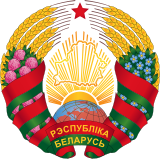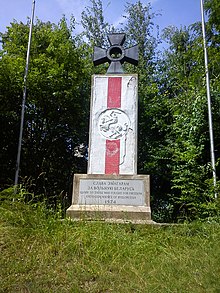Belarusian Americans
Беларускія амэрыканцы | |
|---|---|
| Total population | |
| 600,000[1] (without descendants) | |
| Regions with significant populations | |
| New York, New Jersey, Connecticut, Cleveland, Chicago, Los Angeles, Detroit, Minneapolis | |
| Languages | |
| Belarusian, Russian, American English | |
| Religion | |
| Predominantly Orthodoxy, Roman Catholicism, Judaism | |
| Related ethnic groups | |
| Russian Americans, Ukrainian Americans, Rusyn Americans, Polish Americans, other Slavic Americans |
| Part of a series on |
| Belarusians |
|---|
 |
| Culture |
| By regions |
| Closely related peoples |
| Religion |
| Languages and dialects |
| Topics |
Belarusian Americans, also known as White Russian Americans[2] and White Ruthenian Americans[3] (Belarusian: Беларускія амэрыканцы, Biełaruskija amerykancy), are Americans who are of total or partial Belarusian ancestry.
History
There is an assumption that the first Belarusian settlers in the United States, who settled there at the beginning of the 17th century in Virginia, could have been brought as Slavic slaves by Captain John Smith, who visited Belarus in 1603.[3] The first wave of mass emigration from Belarus started in the final decades of the nineteenth century and continued until World War I. They emigrated to the United States via Libava (Liepāja, Latvia) and northern Germany. When they arrived, most settled in New York, Philadelphia, Boston, and Baltimore. However, most of these first Belarusians were registered either as Russians (those who were Orthodox Christians) or as Poles (Roman Catholics).[3] This was because the first wave of immigrants came before the full development and spread of Belarusian nationalism.[4][5] Most ethnic Belarusians (those who were not genetically or culturally Polish, Lithuanian, or Jewish) considered themselves to be Russian.[4][6] Furthermore, even today, those who descend from pre-World War I immigrants often use the more archaic term "White Russian" to describe their ancestry instead of "Belarusian".[2]
Demography

According to the 1990 United States Census, only 4,277 respondents claimed Belarusian ancestry; there are no reports as to the estimated population from the 2000 census.[7] The majority of the pre-Revolutionary immigrants from Belarus who were ethnic Belarusians identified as Russian, more or less holding Russophilic or Westrussianist views.[8][9] A large portion of the Russian American community consisted of immigrants from Belarus. Belarus had, and still has, a Polish minority consisting of ethnic Poles, the descendants of the Polish nobility and gentry, as well as descendants of Polonized Belarusian peasants.[10][11] In addition, the term "Belarusian" only became common near the end of the Soviet Union's existence, and most persons of Belarusian ancestry in the United States would be unaware of the term, referring to themselves as "White Russian" rather than "Belarusian".
Since it was customary in American English of that time to use a historical Ruthenian designation for various East Slavic peoples, Belarusians in the U.S. were sometimes referred to as White Ruthenians. For example, the first Belarusian-American newspaper, Belaruskaja trybuna (Belarusian: Беларуская трыбуна, lit. 'Belarusian Tribune'), was published since 1926 by the Whiteruthenian National Association, and had an English subtitle: Whiteruthenian Tribune.[12]
The largest concentrations of Belarusian Americans are in the metropolitan New York area, New Jersey (especially Highland Park and South River), Cleveland (and its suburbs), Chicago (recent immigrants concentrated around Wheeling), Los Angeles, Sacramento (largely around Orangevale and North Highlands) and Detroit.
There were several waves of Belarusian influx into the U.S., one before the Russian Revolution, then in 1919-1939 from Western Belarus, then in the late 1940s-early 1950s (after the Second World War), and after the collapse of the USSR in the 1990s.
One major group of Belarusian immigrants to the U.S. are Belarusian Jews who migrated starting in the mid-19th century, having faced discrimination in the Russian Empire, which Belarus was part of at the time.
According to the 2000 Census Bureau report,[13] 38,505 people who were born in Belarus lived in the United States. 1,363 of them spoke the Belarusian language at home.[14]
Belarusian-born population
Belarusian-born population in the U.S. since 2010:[15]
| Year | Number |
|---|---|
| 2010 | 56,217 |
| 2011 | |
| 2012 | |
| 2013 | |
| 2014 | |
| 2015 | |
| 2016 |
Education and culture
There are several organizations in the United States that have developed a system of secondary schools in places with communities of Belarusian descent. These organizations have the goal of teaching the language, culture, and religious traditions of Belarus. Thus the Belarusian culture is represented by choirs, theatrical groups, and musical and dance ensembles. One of the more prominent associations is the Belarusan American Association.[3] Red, white, black and green colors dominate in the national costume. The national costumes differ depending on the region of Belarus. In the 1950s the St. Euphrosynia Belarusian Orthodox Church was created in South River, New Jersey.
Cuisine
Belarusian cuisine has left a trace in the life of the Americans. One of the proofs is the traditional bagel. The Americans also know Belarusian pierogi, kielbasy and cabbages. The Belarusian cuisine is dominated by various grains, potatoes, beef, pork and mushrooms. Actually, many dishes are cooked from potatoes; for example, draniki, babka, etc. There are also dishes similar to the ones of neighboring countries (Lithuania, Latvia, Ukraine, Russia, Poland): cabbage rolls, bortsch, cold beetroot soup or meat jelly.[16]
Notable people
| Lists of Americans |
|---|
| By US state |
| By ethnicity |
See also
References
- ^ Как живешь, белорусская диаспора? [How are you, Belarusian diaspora?]. belarustime.ru (in Russian). 2006. Archived from the original on March 13, 2012.
- ^ a b American Immigration: A Student Companion. p. 52.
- ^ a b c d Vituat Kipel (2006). "Belarusan Americans". everyculture.com. Retrieved January 14, 2016.
- ^ a b Bekus, Nelly (2010). Struggle over identity: the official and the alternative "Belarusianness". Budapest: Central European Univ Press. ISBN 978-963-9776-68-5.
- ^ Rudling, Per Anders (2015). The rise and fall of Belarusian nationalism, 1906-1931. Pitt series in Russian and East European studies. Pittsburgh, Pa: University of Pittsburgh Press. ISBN 978-0-8229-6308-0.
- ^ Magocsi, Paul R. (1996). The Russian Americans. The immigrant experience (1. print ed.). New York: Chelsea House Publ. pp. 19, 41. ISBN 978-0-7910-3367-8.
- ^ "Belarus". Slavic Heritage Coalition. 1996. Archived from the original on December 29, 2013.
- ^ Гронский, А. Д. (April 27, 2014). "Образ Российской империи и белорусского национального движения в новом школьном учебнике по истории Белоруссии". Archived from the original on April 27, 2014.
- ^ Заблоцкая, М. В. "Идеи «западноруссизма» в политической и культурно-национальной жизни Беларуси в конце XIX — начале XX века" (PDF). Archived from the original (PDF) on December 13, 2013.
- ^ "Belarus History - PolishRoots". www.polishroots.com. Retrieved December 28, 2023.
- ^ Kamusella, Tomasz (2013). "Germanization, Polonization, and Russification in the partitioned lands of Poland-Lithuania". Nationalities Papers. 41 (5): 815–838. doi:10.1080/00905992.2013.767793. hdl:10023/4055. ISSN 0090-5992.
- ^ Kipel 1999, p. 408.
- ^ "Profile of Selected Demographic and Social Characteristics: 2000 - People Born in Belarus" (PDF). U.S. Census Bureau. 2000. Retrieved January 14, 2016.
- ^ "Detailed Languages Spoken at Home and Ability to Speak English for the Population 5 Years and Over for the United States: 2006-2008". U.S. Census Bureau. April 2010. Archived from the original (XLS) on October 19, 2010.
- ^ "American FactFinder - Results". Archived from the original on February 14, 2020. Retrieved April 23, 2018.
- ^ Long, Lucy M. (July 15, 2016). Ethnic American Cooking: Recipes for Living in a New World. Rowman & Littlefield. p. 18. ISBN 978-1-4422-6734-3.
- ^ Gümüş, Gamze Katı (2022). Introduction to Migration Studies (PDF). Springer. p. 565. Retrieved December 19, 2024.
- ^ Kaplan, James (January 1, 2019). Irving Berlin: New York Genius. Yale University Press. p. 280. ISBN 978-0-300-18048-0. Retrieved December 19, 2024.
- ^ Arcari, Maurizio; Papanicolopulu, Irini; Pineschi, Laura (April 22, 2022). Trends and Challenges in International Law: Selected Issues in Human Rights, Cultural Heritage, Environment and Sea. Springer Nature. p. 297. ISBN 978-3-030-94387-5. Retrieved December 19, 2024.
- ^ Gabler, Neal (February 12, 2013). "What Makes Larry Run?". Grantland. Retrieved December 19, 2024.
- ^ "Dick Dale: 'King of Surf Rock' guitarist dies aged 81". BBC. March 17, 2019. Retrieved December 19, 2024.
- ^ "Belarus Jewish community holds memorial for Kirk Douglas, its most famous descendant". Jewish Telegraphic Agency. February 10, 2020. Retrieved December 19, 2024.
- ^ Jenkins, Garry (1999). Harrison Ford : imperfect hero. Secaucus, N.J.: Carol Pub. Group. p. 9. ISBN 978-0-8065-8016-6. Retrieved December 19, 2024.
- ^ O'Brien, Derek (May 17, 2024). "Alex Galchenyuk signs with Amur Khabarovsk". Hockey News. Retrieved December 19, 2024.
- ^ "Larry King, broadcaster whose CNN show was the platform of choice for politicians and celebrities – obituary". The Telegraph. January 23, 2021. Retrieved December 19, 2024.
Sources
- Kipel, Vitaut (1999). Belarusans in the United States. Lanham: University Press of America. ISBN 9780761813064.
